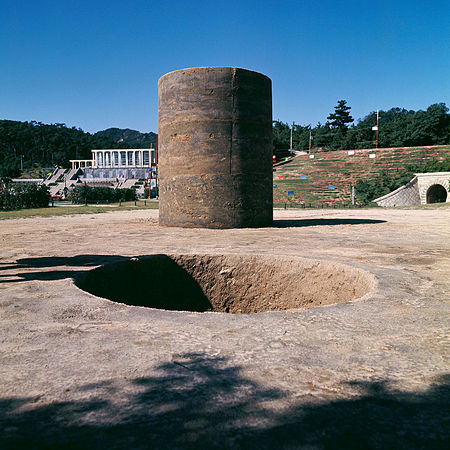There are so many interesting works that I was drawn to, it’s so hard to pick. I finally decided on the work Phase Mother Earth (1968) by Nobuo Sekine.
Sekine is born in Saitama, Japan in 1942. He was trained in painting in Tama Art University in Tokyo between 1962 and 1968, receiving a BFA in Oil Painting. It was here that he was taught by Yoshishige Saito and Jiro Takamatsu. Both were very influential and important artist making art in the 1960s and 70s. Sekine was very influenced by the western movements that influenced his teachers – Takamatsu’s work dealing with Dada, Surrealism and Minimalism and Saito’s European and Russian Constructivism art.
Sekine was part of this collective and movement in Japan called Mono-ha, which translates to “School of Things”. They were interested in exploring the relationships between natural and industrial materials such as steel plates, glass, cotton, wood, rope, water in unaltered, ephemeral states. They would focus on the interdependency of these materials with the surrounding space and on the elements themselves.
Mono-ha was very much shaped by and responded to the socio-political context of the 1960s. Many of the artists in the movements were young graduates starting their careers when the violent student protests of 1968-69 happened. The leftist student movements were protesting against social issues such as the harsh academic conditions nationwide and the unwelcomed American military presence and possibility of a second extension of the US-Japan Security Treaty (which would force Japan into providing logistical support for the US war in Vietnam). Mono-ha artists have denied involvement in the student activist moments but there is no denying that this volatile environment gave the artists reason and leeway to experiment and represent their unease, feelings of displacement and disillusionment of post war sensibilities.

Phase – Mother Earth is often considered to be the initial work of the Mono-ha movement, as well as a turning point in Sekine’s career. The work in Suma Rikyu Park in Kobe consisted of a cylindrical hole in the ground measuring 2.7 meters deep and 2.2 meters in diameter. The displaced earth is then compacted into a cylinder of the exact same dimensions beside the hole.
Personally, I don’t believe that Mono-ha set out to be a Minimalist movement of the East. It did not purposely incorporate elements and defining features of Minimalism. Rather, it’s the ideals of Mona-ha was best represented and materialised in ways that could be seen as features of Minimalism. In Phase – Mother Earth’s case, the work has very clean lines creating geometric shapes. A simple cylindrical pile of earth and a cylindrical hole in the ground. No fancy embellishments or post processes. It is literally in its most raw form. The idea governing the work is serene and clear – a visual recreation of mathematical topology whilst engaging with the concept of “phase”. It deals with the connectedness – between humans and the space, as well as abstract space – how properties of space are persevered under continuous deformations (think voids).
Despite not seeing the actual work in real life in front of me, the monumental size of the work physically and its giant ideal/meaning (mentally) behind it does not wane. Somehow, I was able to feel the immense presence of both the thought behind the work and its physicality through a photograph on the wall. Sometimes, certain artworks are just so powerful that they transcend boundaries.
It is very interesting to note that Sekine names his artworks Phases of [something]. For instance, Phase of Nothingness (1969/70) is a sculpture presented at the Venice Biennale. It consists of a rock placed atop of stainless steel cuboid column. The cuboid is polished till it becomes mirror-like, reflecting its surroundings and almost seems to disappear from view. This creates the illusion that the heavy stone is floating on air, making it look cloud-like and effortless, which sorely contradicts a stone’s association as being very heavy. The play of materiality, creation of voids (“emptiness” under the rock) and the way we perceive things and spaces are explored here. The obsession in the commanding values and interests in the Mono-ha movement are clearly seen.

Perhaps for many of these artists (exhibited in this show), Minimalism is not a constant thing on their minds, or even crossed their minds. It just so happens that their work is best represented and executed in this serenity and simplicity that is often evoked in Minimalism works in the West, therefore the comparisons and associations to Western Minimalism.
Also, after walking through this exhibition, it made me question myself, how much is too much? How little is too little? What’s the fine line between effectively communicating ideas? I feel that these are very important things to think about as an artist or a designer. It reminds of the Thoughtful Interactive Design reading reflection we just did and how (from a subchapter) how the final design may be important, but the process and the designers’ (Mono-ha artists) approach to understanding the different problems (in the socio-political scene) (and even situations whereby solutions lead to new and more problems) and navigating through the ever-changing landscape is equally, if not more important.
An extra thing:
I found this article written by Alfonse who feels that the Minimalism exhibition is lacklustre, an amalgamation of works forced into the confines of what minimalism is. (https://hyperallergic.com/483840/a-show-on-minimalism-lacks-its-self-assured-presence/)
I agree that his view of “the acute absence of Minimalist works from/in Southeast Asia, and a lack of suitable explorations of why such a monumental movement failed to take root in the region”. I feel this is true since I didn’t quite learn or understand why the minimalism movement didn’t take root in this region when I walked through the exhibition. I saw how the movement took form in other places in other kinds of manifestations than I typically associate as defining points of minimalism. Yet nowhere did I feel its lack of presence in Southeast Asia was addressed through the exhibit. Nonetheless, I understand the restrictions the curators faced/went through to procure works and subsequently relabelling them as falling under the category of Minimalism. The curator is free to curate based on his/her definitions and set parameters of minimalism – which in this case differs from Alfonse.
